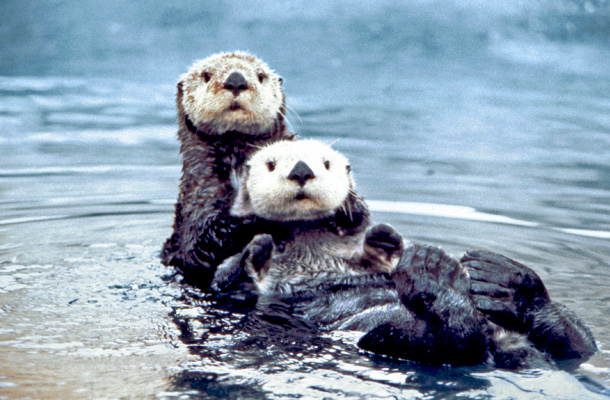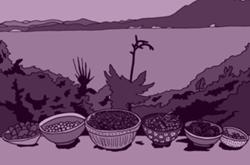New risks from Canadian oil tanker spills confront the 1,100 sea otters living around the Olympic Peninsula, said an internal report of March 2014 by the Washington State Ecology Department.
The otters live from Point Grenville to Neah Bay on the rocky and perilous west coast of the state, about half of them around Destruction Island. Their cousins who share the Salish Sea north of the B.C. border are considered an endangered species in Canada.
"The relative risk of an oil spill occurring near the mouth of the Strait of Juan de Fuca may increase by over four times with the development of new oil transport facilities in British Columbia, Canada and Washington State," said the report. These include the Northern Gateway plan, the Trans-Mountain pipeline expansion, and proposed changes at Delta Port.
A spill near the 153-kilometre long Juan de Fuca Strait could spread south throughout the state's otter habitat: "It is conceivable that a large oil spill could result in a devastating impact on the Washington sea otter population, possibly resulting in its extinction," warned the report, found by The Tyee under the state's freedom of information law.
Spectre of Valdez spill
Oil spills endanger otters because they have a very high metabolism, lack insulating blubber, and rely on their dense fur for warmth. When their fur becomes oiled, they lose their thermal protection and ability to forage for food, all of which can quickly lead to hypothermia and death.
The authors recalled that 2,800 sea otters were killed in the 1989 Exxon Valdez Oil spill in Prince William Sound in Alaska. Despite exhaustive labours by rescuers, only 357 oil injured otters were captured and treated, of which 34 percent died.
The Valdez spill of up to 120,000 cubic meters of crude oil also killed about 250,000 seabirds, 300 harbour seals, 250 bald eagles, 22 killer whales, and an unknown number of salmon. Last March on the 25th anniversary of the spill, scientists from the U.S. National Oceanic and Atmospheric Administration reported that some species seem to have recovered, with the sea otter the latest one to return to pre-spill numbers.
The Washington State Ecology Department study considered three possible solutions -- try to prevent spills, improve spill response, and find new methods to rescue oil injured otters. The Valdez spill indicated the first option is by far the best way of helping the otters, but "unfortunately, the total volume of oil transported is expected to rise."
"The logistics of reaching and collecting animals on the wild coast of the Olympic Peninsula is very difficult. The completely exposed nature of the Washington coast will likely present a challenge even greater than the one presented by the Exxon Valdez oil spill with regard to collecting oil injured sea otters."
Around Destruction Island, there are four "protective strategies" that might help the otters: placing booms to stop the oil spread, dropping chemical oil dispersants, restricting vessel traffic around the island, and skimming the oil off the water. Because the waters on the Washington coast are often so rough, they noted, the booming and skimming strategies are "impractical," and so applying dispersants before the oil's arrival is the best response.
Loose-knit response network
The Point Defiance Zoo and Aquarium, the Seattle Aquarium, the Vancouver Aquarium and the Oregon Coast Aquarium have made informal commitments to help the oiled otters. "This is noble on the part of these institutions," the authors noted, "but without clear contracts or agreements it may not work. These groups likely do not retain enough surplus capacity to perform their primary functions and support ongoing wildlife rehabilitation operations."
Clint Wright, Vancouver Aquarium's general manager, told The Tyee that its Marine Mammal Rescue Centre has pledged to rescue and rehabilitate the American oiled otters as it did during the 1989 Valdez spill. But it can only do so if enough staff are free, as the summer months are the centre's busiest, and before accepting the otters they would need permits issued by the U.S. Fish and Wildlife Service. The Aquarium did take in an otter from Washington in 2012 because it was the only rescue centre within a reasonable distance.
More and bigger tankers slated
The proposed $5-billion expansion of Kinder Morgan's TransMountain pipeline would triple its capacity to 890,000 barrels per day, as it carries Alberta oil sands diluted bitumen to Burnaby, to be then shipped in tankers (with a rise from four to 34 transits per month) through Vancouver harbour, the Straight of Juan de Fuca and the Salish Sea -- otter habitat on both sides of the Washington state border with B.C.
Public letters of comments upon the plan are due to the National Energy Board this September, with the NEB's recommendation likely to come in July 2015.
Contacted by The Tyee, a spokesperson for TransMountain said the firm's application to the National Energy Board to expand the pipeline did not include a rescue plan for otters.
Department of Fisheries and Oceans spokesperson Mélanie Carkner noted Canada's federal government has paid $50 million over two years to implement the Species at Risk Act, which includes otters.
Sea otters were placed in the SARA, and DFO formed a recovery team in 2002 to develop a National Recovery Strategy for the Sea Otter in BC, which was completed five years later. This strategy includes monitoring the otters' health, assessing the potential for oil spills to impact otters and their habitat by modelling spill trajectories, and studying the impact of proposed oil and gas exploration on otter recovery.
Northern cousins face challenges
Otters at the northern end of B.C. also face new challenges. Enbridge's planned $5.5 billion Northern Gateway project would construct twin pipelines that could send more than half a million barrels a day of diluted bitumen from Alberta to Kitimat B.C., whereupon the oil would be shipped in tankers to Asia. Last December the NEB recommended the Gateway plan proceed, and federal cabinet approved the plan this month.
Tankers would forge through the Dixon Entrance, the passage between Alaska and the Queen Charlotte Islands that is governed by both nations. Risks to sea otters are explained in the Canada-U.S. Marine Spill Pollution Contingency Plan, 2010 edition.
Sea otters, harbour seals, Steller sea lions, killer whales, and harbour porpoises can be seen in the Dixon Entrance all year long. Otters are gregarious and almost exclusively aquatic, as they feed, breed and rear their pups near shore. They are harvested by Alaskan native bands for subsistence or selling handicrafts and -- as distinct from Canadian law -- the Southeast Alaska otters do not have any special status under the U.S. Endangered Species Act.
Gateway spokesperson Ivan Giesbrecht told The Tyee that Gateway has a three stage response plan for otters: First, its monitoring program will identify the numbers of otters and their habitat. Second, spill containment plans will focus on those areas for protection and cleanup. Third, it will work closely with government to start an oiled animal rescue and rehabilitation program.
"Oil spills are the single greatest anthropogenic threat to sea otters," the Contingency Plan noted. Besides freezing to death from their oiled fur in a spill, they can be harmed by inhaling volatile hydrocarbons from the petroleum, ingesting oil during grooming, and eating contaminated prey. A large spill could kill the breeding population, cause chronic health effects to survivors, and contaminate food resources. "Studies of sea otters affected by the Exxon Valdez oil spill have shown decreased survival rates in the years following the spill."
There are response plans by government wildlife agencies -- the Canadian Wildlife Service, Fisheries and Oceans Canada, the B.C. Ministry of Environment, the U.S. Fish and Wildlife Service, and the Alaska Department of Fish and Game -- all acting under the joint authority of the Coast Guards of both nations.
Their first strategy is to stop oil from reaching the otters or visa versa. This could mean skimming and booming or -- rarely -- using chemical dispersants or in situ burning (although not dispersants). Capturing otters in the path of a spill might be done but only as a last resort due to the "shock and stress" that can result from the pursuit. Overall, "capturing and treating oiled sea otters has had limited success, with high mortality occurring for a variety of reasons."
Launching hundreds of new oil tanker voyages along North America's west coast poses a hazard to wildlife that must be balanced against financial gains, a Harper government spokesperson told The Tyee. "The government recognizes that it must protect species at risk while also maintaining economic stability and sustainable industries." ![]()
Read more: Energy, Environment















Tyee Commenting Guidelines
Comments that violate guidelines risk being deleted, and violations may result in a temporary or permanent user ban. Maintain the spirit of good conversation to stay in the discussion.
*Please note The Tyee is not a forum for spreading misinformation about COVID-19, denying its existence or minimizing its risk to public health.
Do:
Do not: